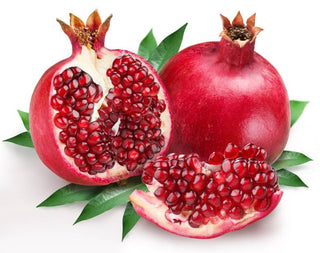(Punica granatum)
A lush, sensual fruit associated with health and rebirth, pomegranates abound in ancient legend. Remains of pomegranates dating back to 1,000 B.C. have been discovered in ancient tombs; wild pomegranate groves grew outside ancient abandoned settlements; and some scholars even place a pomegranate tree in the Garden of Eden, instead of an apple tree.
Perhaps the pomegranate is an ancient apple. The word “pomegranate” derives from the Latin pomum (“apple”) and granatus (“seeded”).
A medium pomegranate is about the size of a large orange. The fruit has a rounded hexagonal shape, and a leathery, deep red to purplish red rind. Pomegranate fruit tastes sweet with a hint of tartness but the sugar content and sweetness differs by variety.
When a pomegranate is split open, a mass of red seeds in a spongy white membrane is revealed. Only the arils (seeds encased in a juice sac) which range in color from white to deep red or purple are edible. From the arils, the sweet, tart, gem-like juice is made.
Pomegranates are drought tolerant – native to drier regions of the Mediterranean Basin, Persia and the Himalayas. Spanish settlers first introduced pomegranates to the United States in 1769. Today they are grown in the drier parts of California and Arizona.
Nutrition
The edible seeds of the pomegranate are not only delicious but nutritious. Half of a medium sized pomegranate, has 130 calories which come primarily from carbohydrates (29 grams). However, this serving size provides 6 grams of fiber (24% of daily values) and 3 grams of protein.
Pomegranates are an excellent source of vitamin C, vitamin K, folate and copper. The seeds are also a good source of the B-vitamins thiamin, B6 and pantothenic acid. Half a pomegranate provides over 300 mg of potassium, a nutrient that is lacking in most American's diet.
Pomegranate juice has become more popular in the past few years, partly due to the POM Wonderful's brand advertising efforts. In addition, a number of superfruit beverages like Mona Vie include pomegranate juice in their superfruit blends.
Like most fruit juices, pomegranate juice is relatively high in calories and sugar. An 8-ounce serving has 136 calories, 32 grams of sugar and no fiber. As is the case with most fruits, it is better to eat the fruit whole as opposed to the juice for maximum health benefits.
Health Benefits
Many of the health benefits associated with pomegranates are due to the phytonutrients found in the fruit. One of these compounds called punicalagins has strong antioxidant properties. Preliminary research has found the juice of pomegranate to be effective in reducing heart risk factors including oxidation of LDL or “bad” cholesterol and reducing systolic blood pressure. Pomegranate juice may be effective against prostate cancer, lung cancer and osteoarthritis but studies are inconclusive.
Selection & Storage
The best pomegranates can be found from October to January, when the crop is harvested. Since pomegranates are picked ripe, they come to market ready to eat. When selecting a whole pomegranate, choose a fruit that is plump, round and heavy for its size without cracks or splits.
Whole pomegranates can be stored in a cool, dry space for about 1 month or for up to 2 months in the refrigerator. When stored, pomegranates become more juicy and flavorful.
Recipes
Pomegranate seeds add zest and color to almost any dish. Top off your morning yogurt or oatmeal with pomegranate seeds for a powerful flavor boost and added fiber. Sprinkle pomegranate seeds onto your favorite salad.
For the holidays, you may want to try a Pomegranate Margarita. For this and all types of delicious pomegranate recipes, check out the Pomegranate Council’s website.
If you're preparing a pomegranate and don't want to stain your clothes or the counter tops, the Pomegranate Council offers the "3-Step No Mess" way to obtain the fruit:
1) Cut off the crown and then cut the pomegranate into 4 sections.
2) Place the sections in a bowl of water then roll out the arils with your fingers, discarding everything else (the arils sink and the inedible pulp floats).
3) Strain out the water and then enjoy the fruit!
Fun Facts
Pomegranate trees produce beautiful, vibrant red flowers. Some pomegranates are grown for their flowers alone.
Grenadine syrup is thickened and sweetened pomegranate juice that is used in cocktails.

